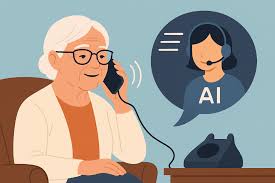 As interviews begin, ideas for the future of AI and older adults are emerging. For the updated report, The Future of AI and Older Adults 2030, suggestions for the future are key to the conversation. As interviews are scheduled and completed, recommendations emerge. These ideas are sensibly building on what would be useful for older adults, coupled with what has already been delivered in the marketplace. For each of these ideas, the report will also consider the barriers that may hobble full adoption, including lack of awareness, training (both for the consumer side and professional), and acceptable cost. But for now, imagine that by 2030:
As interviews begin, ideas for the future of AI and older adults are emerging. For the updated report, The Future of AI and Older Adults 2030, suggestions for the future are key to the conversation. As interviews are scheduled and completed, recommendations emerge. These ideas are sensibly building on what would be useful for older adults, coupled with what has already been delivered in the marketplace. For each of these ideas, the report will also consider the barriers that may hobble full adoption, including lack of awareness, training (both for the consumer side and professional), and acceptable cost. But for now, imagine that by 2030:
AI companions will be proactive and predictive. Whether it is pure software (as many companion tools are today) or built into devices, the key to companion utility will be solid understanding the profile of the care recipient and needed services and support. While some warn about the risks of AI companions (particularly for the young), in the future these companions will combine knowledge of older adult characteristics, including a health profile, the role of family members and caregivers, and who to notify in the event of an issue.
Chatbots will be personalized to an individual and processed locally. Chatbots are a big market as of 2025. It is interesting to think that 88% of people today have had at least one conversation with a chatbot. Today they now offered up on nearly every senior living website, even as their utility may be debated. But if well-designed, they can assist prospective residents, families and employees in ways that free up staff for more challenging tasks.
Special purpose AI agents will be broadly adopted in senior living and home care. As chatbots populate the front door of companies, AI agents will be deployed inside the organization for accomplishing specific tasks – like shopping or scheduling appointments. Given the growing population of older adults living alone, it is feasible by 2030 that AI agents will be deployed for communicating with isolated older adults, during the off hours when a caregiver is unavailable – or full-time for adults who live alone without caregivers.
Sensors at home will talk to each other through a companion hub. After so many years, one might think that integration of sensors in the home through a hub would be commonplace. And this smart home deployment is growing, per AARP’s statistic of 60% of the 50+ are using smart home devices. But are these integrated through a hub or standalone deployment, basically one at a time? The report doesn’t say, but by 2030, frustration with owning multiple (and multi-vendor) devices will likely prod adoption of hubs.

 As interviews begin, ideas for the future of AI and older adults are emerging. For the updated report,
As interviews begin, ideas for the future of AI and older adults are emerging. For the updated report,